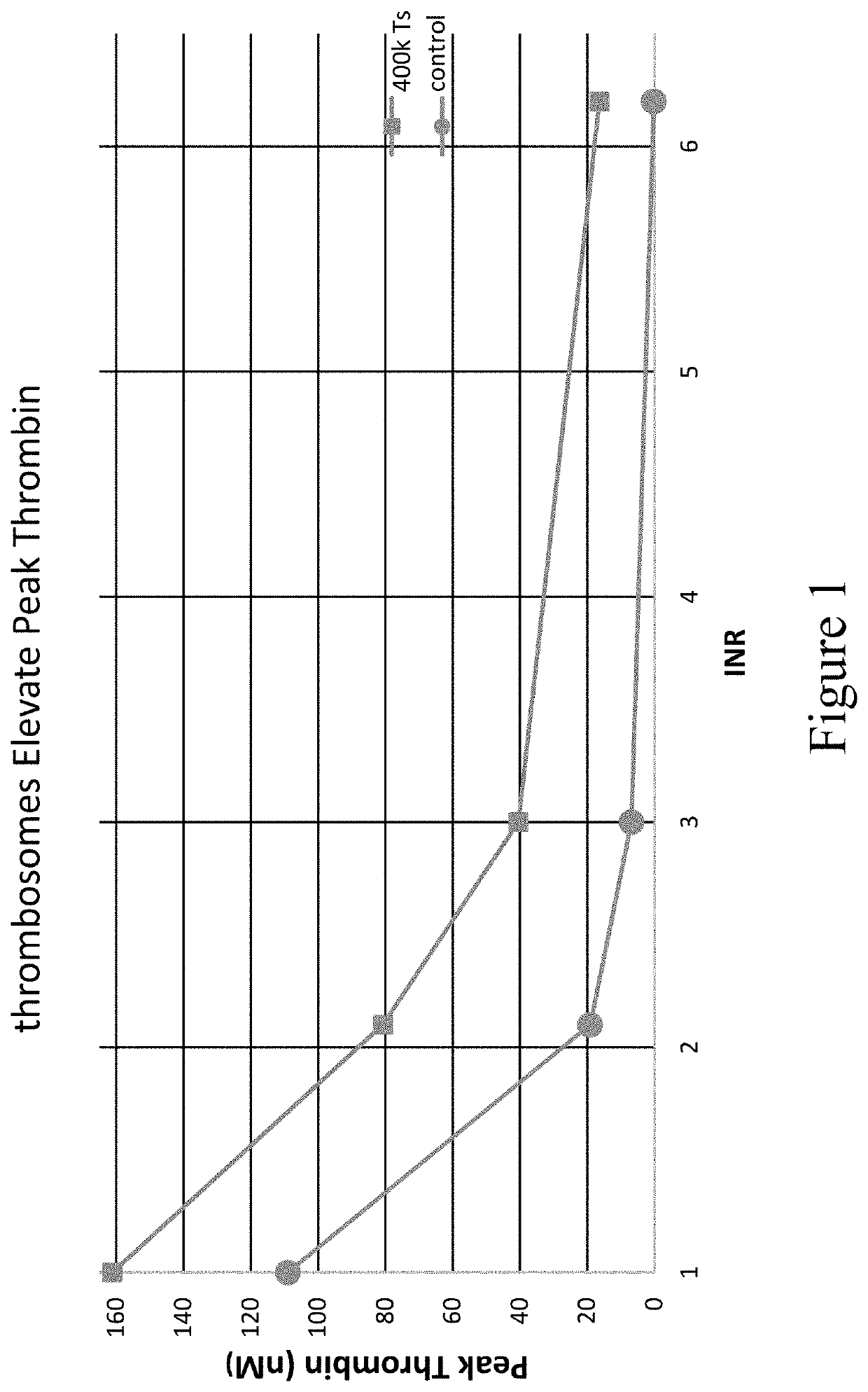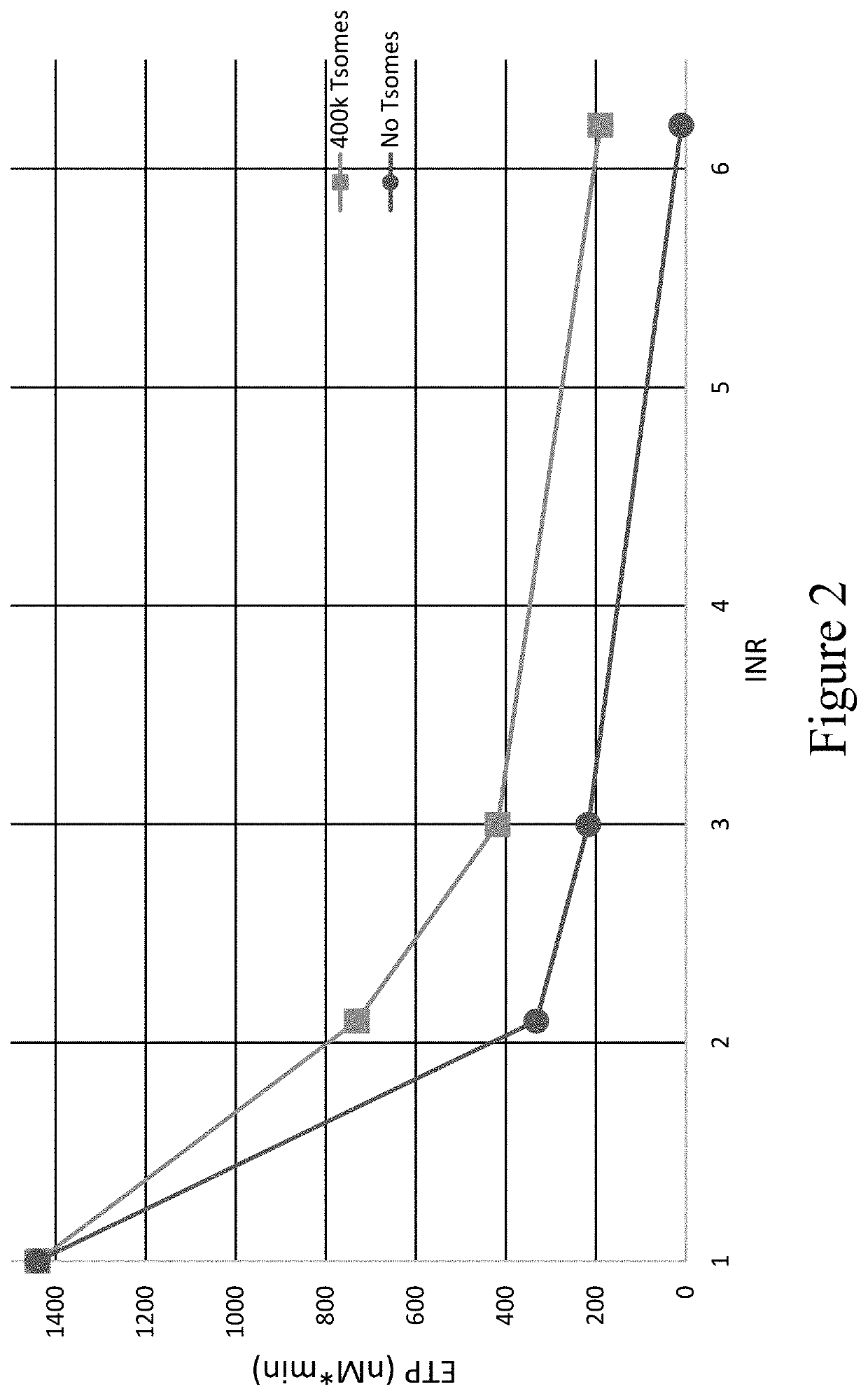Thrombosomes as an anticoagulant reversal agent
a technology of thrombosis and reversal therapy, which is applied in the field of thrombosomes, can solve the problems of increased bleeding potential, warfarin reversal therapy can also be very expensive, and noacs have similar bleeding risk to coumadin, so as to achieve the effect of stopping the anticoagulant and continuing the treatment with the anticoagulan
- Summary
- Abstract
- Description
- Claims
- Application Information
AI Technical Summary
Benefits of technology
Problems solved by technology
Method used
Image
Examples
example 1
[0269]The results that follow demonstrate the impact of the thrombosomes product in an in vitro model for patients taking warfarin, a common anticoagulant drug. Warfarin inhibits the synthesis of numerous hemostatic plasma proteins in the liver that are dependent on vitamin K.
[0270]Thrombosomes and other lyophilized platelet products are designed for infusion into a patient's bloodstream following diagnosis of trauma or hemostatic failure. In the following Examples modeling patients using warfarin, thrombosomes were introduced first into a plasma-based system, followed by a whole-blood system in Example 2 to more closely mimic conditions in vivo.
[0271]In the plasma model, thrombosomes demonstrated a noticeable improvement in thrombin generation (TGA) and thromboelastography (TEG) assays.
[0272]The samples used in the plasma model were prepared by combining 1:1 volumes of warfarin plasma (source: George King Biomedical, at various INR values) or platelet-rich plasma (PRP) and Control ...
example 2
od Assays
[0284]Once the impact in plasma was established, thrombosomes were introduced into a similar warfarin model using donor whole blood. Thrombosomes were prepared consistent with the procedures described in U.S. Pat. No. 8,486,617 (such as, e.g., Examples 1-5) and U.S. Pat. No. 8,097,403 (such as, e.g., Examples 1-3), and rehydrated by addition of sterile water. To generate comparable anticoagulant conditions, the native plasma of type O donor blood was removed and replaced with warfarin plasma as described in Example 3. TGA assays were performed as described in Example 3. FIG. 5 shows that thrombosomes provide a dose-dependent effect on peak thrombin generation. In FIG. 5, data were collected in the background of whole blood with an endogenous platelet count of 150×103 / μL. An increase in peak thrombin was observed in particular at INR 3.0 and 6.2 in FIG. 5. The roughly 50% increase in peak thrombin (at INR 3) in vitro may translate to significantly lower bleeding in vivo as t...
example 3
s
[0285]Whole Blood Sample Preparation[0286](1) Obtain type O donor whole blood in NaCitrate (blue-top) vacutainer tubes.[0287](2) Centrifuge the blood at 2000×g for 10 minutes.[0288](3) Carefully pipette off the plasma, leaving the buffy coat intact[0289](4) Add a volume of HEPES-buffered saline (HBS) equivalent to the removed plasma and gently resuspend the whole blood.[0290](5) Spin the blood again for 10 minutes at 2000×g.[0291](6) Carefully remove the supernatant, leaving the buffy coat intact.[0292](7) Incrementally resuspend the blood in warfarin plasma, normal plasma (function control), or autologous plasma (process control) until the measured hematocrit is equivalent to the hematocrit of the donor's fresh whole blood.[0293]a. Store at room temperature for up to 4 hours.[0294](8) Combine 1:1 volume with Control Buffer with or without thrombosomes immediately before running any samples.
[0295]Thromboelastography Assay (TEG® 5000 THROMBOELASTOGRAPH® Hemostasis Analyzer System)[0...
PUM
| Property | Measurement | Unit |
|---|---|---|
| temperatures | aaaaa | aaaaa |
| temperatures | aaaaa | aaaaa |
| period of time | aaaaa | aaaaa |
Abstract
Description
Claims
Application Information
 Login to View More
Login to View More - R&D
- Intellectual Property
- Life Sciences
- Materials
- Tech Scout
- Unparalleled Data Quality
- Higher Quality Content
- 60% Fewer Hallucinations
Browse by: Latest US Patents, China's latest patents, Technical Efficacy Thesaurus, Application Domain, Technology Topic, Popular Technical Reports.
© 2025 PatSnap. All rights reserved.Legal|Privacy policy|Modern Slavery Act Transparency Statement|Sitemap|About US| Contact US: help@patsnap.com



